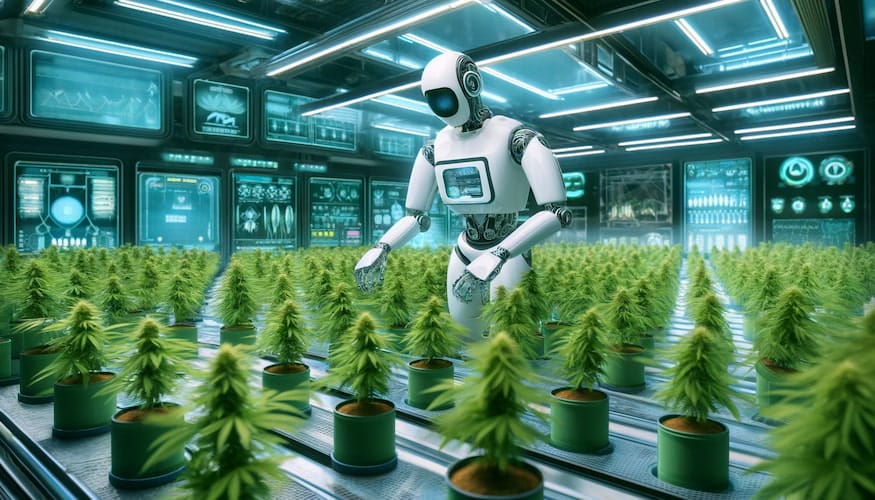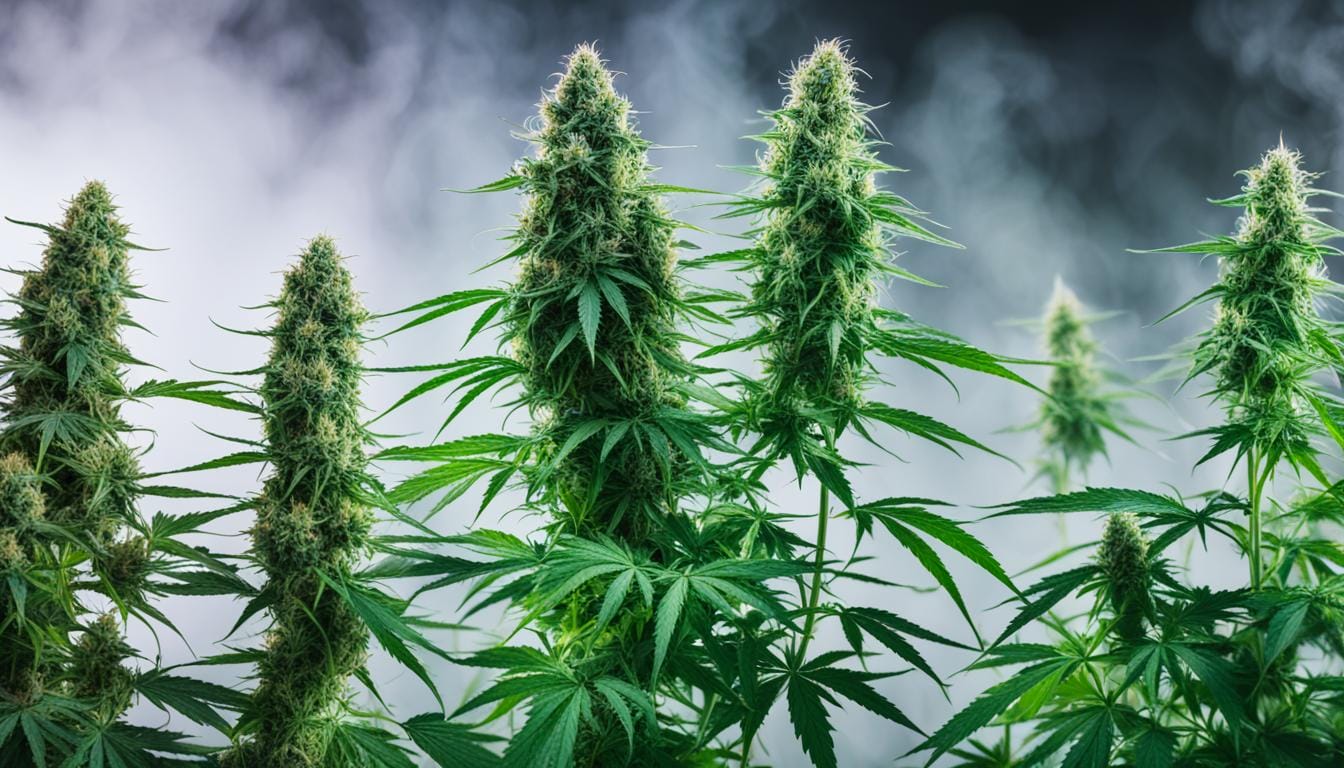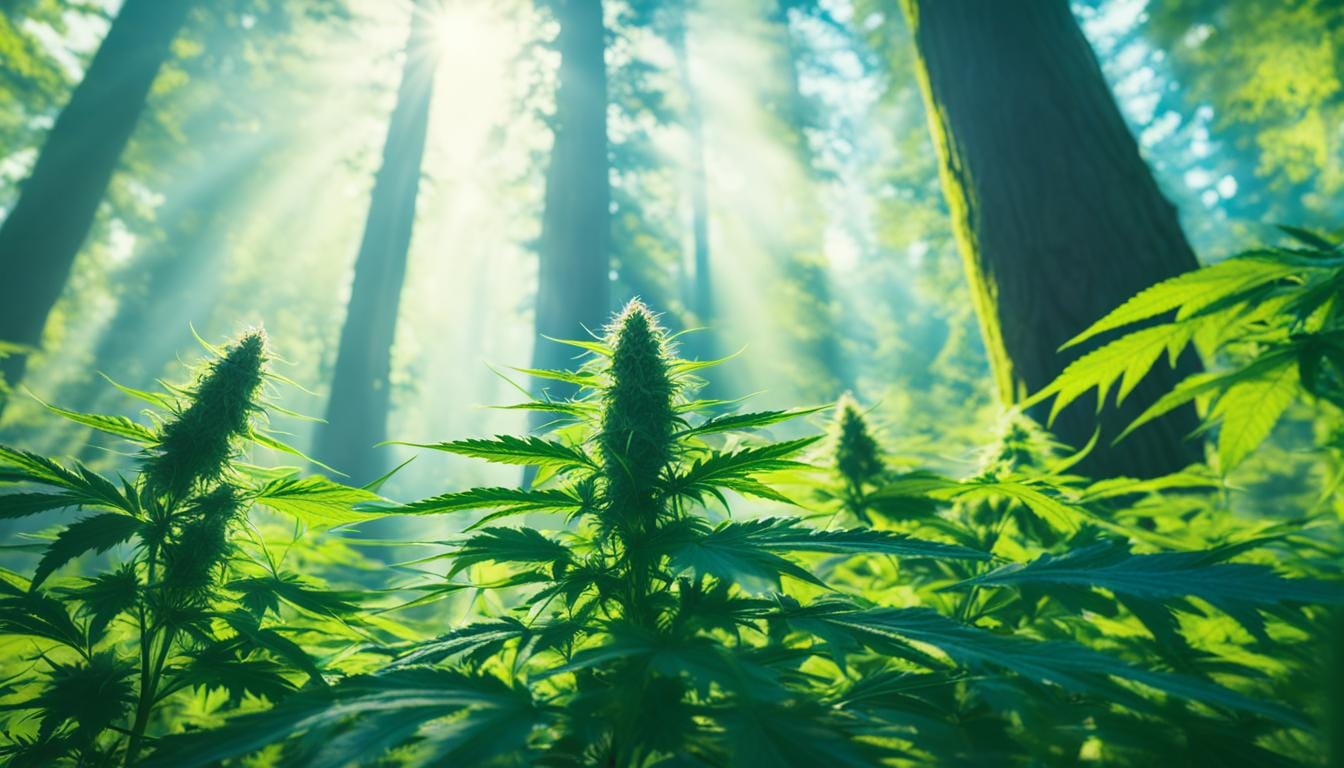Introduction to AI in Agriculture The integration of Artificial Intelligence (AI) into agriculture is no longer a futuristic concept but a transformative reality. In the realm of agriculture, AI’s potential to optimize processes, maximize yields, and sustain environmental resources is unparalleled. This is especially pertinent in specialized sectors such as cannabis cultivation, where precision and […]
Marijuana Flowering Stages: Key Phases of Cannabis Growth
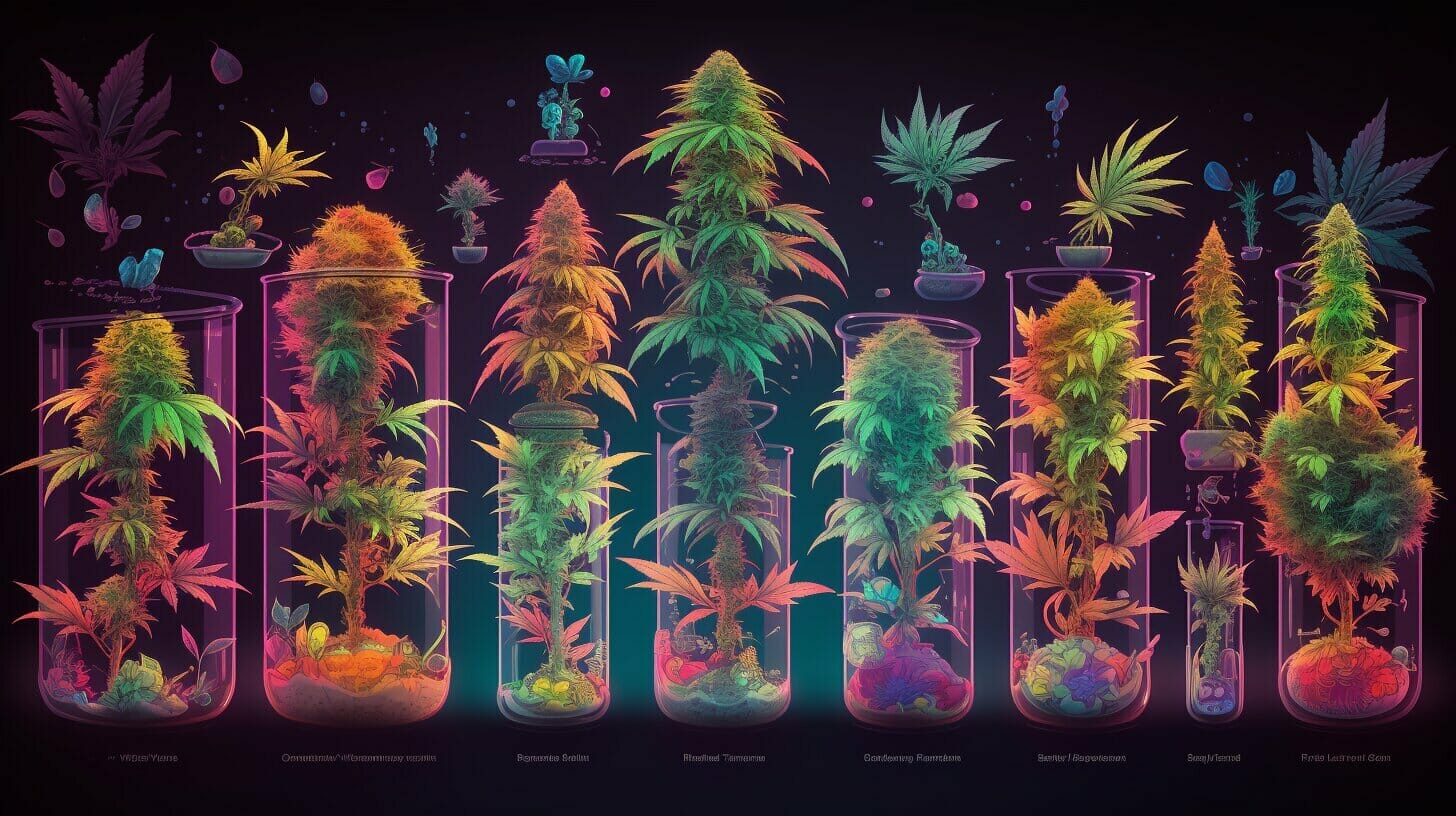
As a cannabis grower, understanding the marijuana flowering stages is crucial for optimizing your plant’s yield and potency. The flowering stage is when your plants shift their energy towards producing buds, and it requires different growing conditions than the vegetative phase.
In this article, we’ll provide a comprehensive guide to the different phases of cannabis growth, with a focus on the marijuana flowering process. We’ll cover everything from the pre-flowering stage to harvesting and curing, and provide tips for maximizing the quality and quantity of your buds.
Key Takeaways:
- Understanding the different phases of cannabis growth is essential for optimizing yield and potency.
- The marijuana flowering stages require different growing conditions than the vegetative phase.
- In this article, we’ll provide a comprehensive guide to the marijuana flowering process, from pre-flowering to harvesting and curing.
Understanding the Life Cycle of Cannabis Plants
Cannabis plants have a unique life cycle that consists of two main phases: vegetative and flowering. The vegetative stage is the period of growth where the plant focuses on building its structure and developing its leaves and stems.
When the plant reaches maturity, in terms of its size and structure, it begins to transition into the flowering stage. This phase is characterized by significant changes in the plant’s growth patterns, including the formation of buds and increased demand for nutrients.
The transition from Vegetative to Flowering Stage
The transition from the vegetative to the flowering stage is triggered by changes in the plant’s light exposure. Typically, cannabis plants require a 12-hour light cycle to initiate the flowering stage, though some varieties may require longer or shorter light cycles. Once the light cycle is adjusted, the plant’s growth patterns will shift, and the flowering stage will begin.
During this phase, the plant will redirect its energy toward the formation of buds and the development of its reproductive organs. Leaves and stems will continue to grow, but at a slower rate, as the plant diverts its resources towards bud production.
Major Changes During Flowering Stage
The flowering stage is characterized by several distinct changes in the plant’s growth and appearance. The most notable change is the formation of buds, which will begin to appear along the plant’s stem and branches. These buds will gradually become larger and more dense as they mature.
During the flowering stage, the plant will also begin to develop its trichomes. These small hair-like structures contain many of the cannabinoids and terpenes that give cannabis its unique aroma and effects.
Overall, the flowering stage is a critical time for cannabis plants, and it requires careful attention and management to ensure optimal growth and yield.
Pre-Flowering Stage: Transition and Preparation
The pre-flowering stage is a critical stage that prepares the cannabis plants for the flowering phase. This stage is characterized by changes in the plant’s physiology and morphology and can last for one to two weeks. Timing is essential during this phase, and growers must be able to identify when the plants are ready to transition into the flowering stage.
One way to identify when the plants are ready for the flowering stage is by examining the nodes of the plant. Nodes are the points where the branches and leaves of the plant meet the stem. At the pre-flowering stage, nodes will start to develop small, wispy white hairs, which are called pistils.
It is vital to ensure that the plants receive the right amount of light during this phase. Typically, growers will switch to a 12-hour light cycle to encourage cannabis plants to enter the flowering stage. Keep in mind that any light interruptions can delay or disrupt the flowering process, leading to lower yields and weaker buds.
It is also important to provide the plants with the right balance of nutrients during this phase. Nutrients rich in nitrogen should be reduced, while nutrients rich in phosphorus and potassium should be increased. The right nutrient balance helps to promote healthy flowering and bud development.
Early Flowering Stage: Bud Formation Begins
The early flowering stage marks an exciting period in cannabis cultivation as it is the time when buds begin to form. During this stage, plants will undergo significant physical changes in preparation for flowering.
At the onset of the early flowering stage, pre-flowers will have emerged, and plants will have stopped growing taller. Instead, they will focus their energy on developing buds. Female plants will start to produce white pistils, which will eventually develop into buds, while male plants will produce pollen sacs that will eventually burst and release pollen.
| Key Factors | Optimal Range |
|---|---|
| Light Cycles | 12 hours of light and 12 hours of darkness |
| Nutrient Requirements | High in phosphorus, low in nitrogen |
During this stage, growers should continue to provide plants with the appropriate balance of nutrients. It’s important to note that fertilizer ratios should now be adjusted to meet the demands of the flowering stage. High levels of nitrogen should be avoided as they can negatively affect bud development and quality. Instead, phosphorus should be increased to support healthy bud formation.
In addition to nutrient management, growers should also ensure that plants are receiving the correct amount of light. At this stage, plants require a 12-hour-on and 12-hour-off light cycle to stimulate bud production.
“The early flowering stage is a critical period for bud development. By managing light and nutrients appropriately, growers can help plants produce healthy, high-quality buds.”
Mid-Flowering Stage: Bud Growth and Maturation
In the mid-flowering stage, buds continue to grow and mature, reaching their full potential in size and potency. During this phase, the demand for nutrients increases, and the risk of nutrient deficiencies or excesses can affect the overall quality of the buds.
It is essential to ensure that the plants receive the right balance of nutrients, including macronutrients like nitrogen, phosphorus, and potassium, as well as micronutrients like calcium, magnesium, and iron. A balanced pH level is also crucial for nutrient uptake and overall plant health.
As the buds mature, they may become heavy and require support to prevent them from bending or breaking. The use of stakes or trellises can help to keep the plants upright and prevent any damage to the buds.
Growers should also be vigilant about monitoring their plants for any signs of stress or pest infestations, as these can affect the overall yield and quality of the buds. Proper ventilation and humidity control can help to prevent issues such as mold or mildew in the flowering environment.

Tips for Mid-Flowering Stage:
- Monitor nutrient levels and adjust as necessary, keeping a balanced pH level.
- Use stakes or trellises to support the weight of the buds.
- Be vigilant about monitoring for signs of stress or pest infestations.
- Maintain proper humidity and ventilation to prevent mold or mildew.
Late Flowering Stage: Bud Ripening and Trichome Development
The late flowering stage is when buds continue to ripen and trichomes develop, leading to an increase in potency and flavor. It is crucial to monitor the trichomes during this phase to determine the ideal time for harvest. There are three types of trichomes: clear, cloudy, and amber. Clear trichomes indicate that the buds are not yet ready for harvest, while cloudy trichomes indicate that the buds are nearing maturity. Amber trichomes signify that the buds are at their peak potency, but waiting too long may cause the trichomes to degrade.
To maximize the quality and potency of the buds during the late flowering phase, it is essential to maintain optimal growing conditions. It is recommended to continue providing nutrients during this phase, but it is crucial to avoid overfeeding the plants, as this may lead to nutrient burn and affect the flavor. Maintaining ideal humidity levels of around 45-50% can also prevent mold growth and preserve the quality of the buds.
It is equally important to provide the plants with proper lighting during this phase. Using full-spectrum LED grow lights can help increase trichome production and enhance the potency of the buds. However, it is recommended to reduce the light intensity during the last few weeks of the flowering phase to avoid light burn, which can cause the buds to become brittle and lose potency.
Proper pruning and defoliation during the late flowering stage can also improve bud quality and yield. Removing any large fan leaves that may be blocking light from reaching the buds can help improve trichome production. Additionally, trimming away any lower buds that are not receiving enough light can promote healthier growth in the remaining buds.
Harvesting and Curing: Finalizing the Flowering Process
After weeks of carefully nurturing your cannabis plants through the various flowering stages, it is finally time to harvest and cure them. This crucial step in the marijuana flowering process can make all the difference in the final quality and potency of your buds.
The optimal time for harvesting depends on various factors, such as strain, plant maturity, and desired effect. Generally, it is recommended to wait until the pistils begin to darken and curl inwards, and the trichomes turn cloudy or amber.
When harvesting, use clean pruning shears to carefully cut off entire branches, avoiding any damage to the buds. After trimming off the larger fan leaves, hang the branches upside down in a cool, dry, and dark space with good air circulation. This will allow the buds to dry slowly, evenly, and naturally, preserving their aroma and flavor.
Curing is the final step in the marijuana flowering process, where the dried buds are stored in airtight containers in a cool, dark, and dry place for several days to several weeks. This process allows the buds to fully mature, enhancing their aroma, flavor, and potency, while also preventing mold and other contaminants.
| Harvesting Tips: | Curing Tips: |
|---|---|
|
|
Remember that curing is a gradual process, and it may take several days to several weeks to achieve the desired results. Be patient and monitor your buds regularly, opening the jars to release any excess moisture.
With proper harvesting and curing techniques, you can maximize the quality and potency of your buds, ensuring a flavorful and enjoyable cannabis experience.
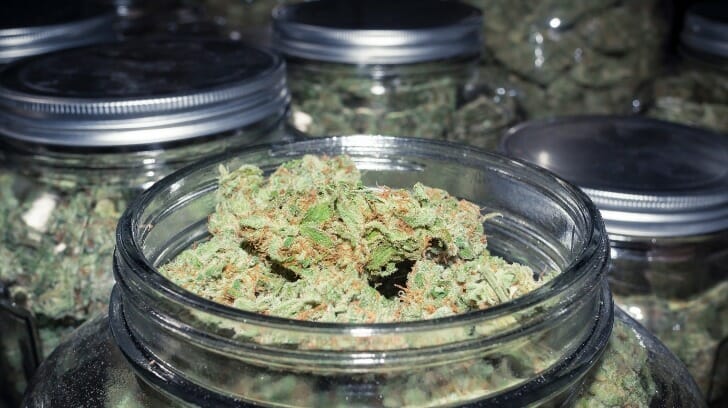
Factors Affecting Flowering and Yield
The marijuana flowering process is influenced by several factors that can impact the yield and potency of the final product. Understanding and optimizing these factors can help growers achieve the best possible results.
Light Intensity
Light is one of the most critical factors influencing cannabis growth. During the flowering stage, the plants require intense light to support bud development. Insufficient light can lead to lower yields, spindly buds, and reduced potency. On the other hand, too much light can cause heat stress, light burn, and other issues. Ensure that the plants receive the appropriate light intensity for their growth stage.
Temperature
Temperature is another crucial factor for successful cannabis growth. During the flowering stage, the ideal temperature range is between 65-80 degrees Fahrenheit. High temperatures can lead to heat stress, reduced potency, and lower yields. Low temperatures can slow down growth and lead to dampness and mold issues.
Humidity
Humidity levels must be maintained at optimal levels during the flowering stage to avoid mold and pest issues. The ideal humidity range for cannabis plants in the flowering stage is between 40-50%. High humidity levels can cause mold, while low humidity can lead to dry buds.
Nutrients
Cannabis plants require the right balance of nutrients at every stage of their growth. During the flowering stage, the plants require higher levels of potassium and phosphorus and lower levels of nitrogen to support optimal bud development. Over-fertilizing or under-fertilizing can lead to nutrient deficiencies or toxicities that can affect yield and quality.
Genetics
The genetics of cannabis plants can significantly impact their growth and yield potential. Some strains are more resistant to pests and diseases, while others may require more attention and care. Choose high-quality seeds from reputable sources to ensure that the plants have the genetics to produce high-quality buds.
Stress Factors
Cannabis plants can be sensitive to stress factors such as pests, diseases, environmental changes, and physical damage. Stress can slow down growth and lead to lower yields and reduced potency. Monitor plants closely and take preventive measures to avoid stress factors during the flowering stage.
Common Problems in Flowering Stages
Despite growers’ best efforts, issues may arise during the flowering stages of cannabis plants. These issues can have a significant impact on the overall yield and quality of the buds. Here are some common problems to watch out for:
Nutrient Deficiencies
During the flowering stage, plants require high levels of phosphorus and potassium. Deficiencies in these nutrients can lead to stunted growth, reduced yields, and lower potency. Make sure to provide adequate nutrients based on the plant’s needs.
Pests and Diseases
Common pests such as spider mites, aphids, and whiteflies can damage plants and reduce yields. Similarly, fungal diseases such as powdery mildew and bud rot can affect the buds’ quality. Regular monitoring and preventive treatments are essential to keep pests and diseases at bay.
Environmental Stress
Flowering plants can be sensitive to environmental stress factors such as temperature fluctuations, high humidity, and light stress. These factors can affect bud formation and reduce overall yield. Ensure that the growing environment is stable and well-maintained throughout the flowering phase.
Genetics
Some strains may be more prone to certain issues than others. Ensure that you choose high-quality seeds or clones from reputable sources to minimize potential problems.
Stress Factors
Stress factors such as overwatering, underwatering, and physical damage can also impact the flowering process. Take care to avoid these stressors and address any issues promptly.
Tips for Successful Flowering
Successful flowering of cannabis plants requires careful attention to various factors that can impact plant growth and yield. Below are some tips and best practices for optimizing the marijuana flowering stages:
- Choose the right strains: Different strains have different flowering times and growth patterns. Consider factors such as the size of the plants, the length of the flowering cycle, and the desired potency and flavor when selecting a strain.
- Maintain proper light cycles: Cannabis plants require a specific light cycle to trigger the flowering stage and promote bud growth. Typically, a 12-hour light cycle followed by 12 hours of darkness is optimal for inducing flowering. Ensure consistent and appropriate lighting conditions throughout the flowering cycle.
- Monitor nutrients: Cannabis plants have different nutrient requirements during each stage of growth. Pay close attention to the nutrient levels during the flowering stage, as the plants require increased levels of phosphorus and potassium for bud development. Avoid overfeeding or underfeeding the plants.
- Prune and train the plants: Pruning and training the plants can help to promote even canopy growth and improve yield. Remove any yellow, wilted, or dead leaves, and use techniques such as topping, super cropping, and low-stress training to encourage lateral growth and maximize light exposure.
- Monitor plant health: Watch for signs of stress, pests, or diseases during the flowering stage. Any issues can impact the quality and yield of the buds. Check the plants regularly for abnormalities such as discoloration, curling leaves, or pests such as spider mites or aphids.
By following these tips and maintaining optimal conditions throughout the marijuana flowering stages, growers can achieve large yields of high-quality, potent buds.
Tips for Successful Flowering
Successful flowering of cannabis plants requires attention to detail and careful management throughout the different phases of growth. Here are some tips to help optimize the marijuana flowering process:
Maintain Proper Light Cycles
Ensure that your plants are receiving the correct amount of light during each stage of growth. During the flowering stage, keep your plants on a consistent 12-hour light and 12-hour dark cycle to encourage bud development.
Manage Nutrients Carefully
Monitor your plants’ nutrient levels closely and adjust accordingly to prevent deficiencies or excesses. During the flowering stage, your plants may require different nutrient ratios than during the vegetative stage.
Prune Strategically
Remove any dead leaves or branches to prevent disease and ensure that the plant is using its energy efficiently. You may also want to consider selectively pruning to encourage larger, more potent buds.
Monitor Plant Health
Regularly check for signs of pests, disease, or nutrient deficiencies. Address any issues promptly to prevent them from compromising the overall quality and yield of your crop.
By following these best practices and staying attentive throughout the flowering stages, you can maximize the yield and potency of your cannabis crop.
FAQ
Q: What are the key phases of cannabis growth during the marijuana flowering stages?
A: The key phases of cannabis growth during the marijuana flowering stages include the pre-flowering stage, early flowering stage, mid-flowering stage, late flowering stage, and the harvesting and curing process.
Q: What is the overall life cycle of cannabis plants?
A: The overall life cycle of cannabis plants includes the vegetative stage and the flowering stage. During the vegetative stage, plants focus on leaf and stem growth, while the flowering stage is when buds start to develop.
Q: What is the pre-flowering stage and why is it important?
A: The pre-flowering stage is the transition period before the flowering stage begins. It is crucial for preparing plants for optimal bud formation. During this stage, growers need to ensure the right light cycles and nutrient levels to support the transition.
Q: When does bud formation begin during the flowering stages?
A: Bud formation begins during the early flowering stage. This is when the plants start to develop the structures that will eventually become buds. Managing light cycles and providing the right nutrients during this stage is essential for healthy bud development.
Q: What happens during the mid-flowering stage of cannabis plants?
A: During the mid-flowering stage, the buds continue to grow and mature. This stage requires increased nutrient levels and careful monitoring of environmental conditions to ensure optimal bud growth.
Q: What is the late flowering stage and why is it important?
A: The late flowering stage is when the buds ripen and trichomes develop, which are responsible for the potency of the buds. Monitoring trichome development helps determine the ideal harvest time. It is crucial to maximize bud quality and potency during this phase.
Q: How should cannabis plants be harvested and cured?
A: Cannabis plants should be harvested at the optimal time, usually when trichomes are fully developed. After cutting the buds, they should be dried and cured properly to enhance flavor and potency. Proper curing involves controlled humidity and temperature levels.
Q: What factors can affect the flowering and yield of cannabis plants?
A: Several factors can impact the flowering and yield of cannabis plants, including light intensity, temperature, humidity, nutrient levels, genetics, and stress factors. Optimizing these factors can help maximize flowering and overall yield.
Q: What are common problems that can occur during the marijuana flowering stages?
A: Common problems during the marijuana flowering stages include nutrient deficiencies, pests, diseases, and environmental stress. Growers should be aware of these issues and take preventive measures or apply troubleshooting techniques to mitigate them.
Q: What are some tips for the successful flowering of cannabis plants?
A: Some tips for the successful flowering of cannabis plants include maintaining proper light cycles, managing nutrient levels, implementing effective pruning techniques, and regularly monitoring plant health. Attention to detail and proactive care are key during the flowering stages.
Q: What is the importance of understanding and optimizing marijuana flowering stages?
A: Understanding and optimizing marijuana flowering stages is crucial for achieving the best possible results in terms of yield and bud quality. By properly managing each phase of the flowering process, growers can maximize their harvest and produce high-quality cannabis.
Back

